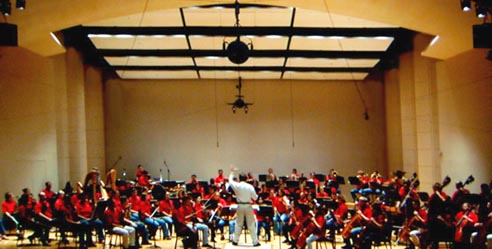IMSC Presents Landmark Internet concert event
Alasdair Neale conducts
the New World Symphony, in a recorded
performance delivered over the Internet on a 30 by 17
foot screen in USC's Bing Theater. IMSC used the Center's
Remote Media Immersion technologies to present the performance
at an Internet 2 Consortium meeting hosted by USC.

Photo by Yi-Shin Chen
IMSC teamed with the New World Symphony (NWS) for a landmark Internet immersive concert performance on campus for an Internet 2 Consortium meeting in October.
"Audiences enjoy realism and a more compelling experience, and with this performance, we demonstrated new technologies that are coupled with the Internet to deliver a significantly enhanced entertainment experience," according to IMSC Director Ulrich Neumann.
Some 500 people in USC's Bing Theater viewed the previously recorded performance by the New World Symphony of a segment of Aaron Copland's Symphony No. 3 as it was streamed over the Internet in high-definition digital video and IMSC's multichannel immersive audio and projected on a specially made 30 by 17 foot screen. Alasdair Neale, NWS principal guest conductor, conducted the performance. Michael Tilson Thomas, the NWS artistic director and founder, addressed the audience over the Internet.
IMSC researchers had recorded the performance several weeks earlier at the orchestra's home theater, the historic Lincoln Theater in Miami Beach, using newly-developed methods to match the requirements of human perception for picture and sound in order to convey a realistic sense of being at the original performance. They used novel audio acquisition methods to accurately capture the sound of the orchestra and the acoustics of the Lincoln Theatre, a landmark institution in Miami Beach's popular Art Deco district.
"It was very compelling," said Prof. James Oliverio of the University of Florida at Gainesville, an audience member. "It was very believable. The video enhanced it, and I was impressed by the sound quality and the immersive characteristics of what we heard in the theater, particularly in the low end and the sub-woofers. That's really the part of a live performance that one feels at a symphony, and that was very well represented here," he said.
IMSC investigators contributing to the project included Deputy Director Alexander A. (Sandy) Sawchuk, Prof. Tomlinson Holman, Prof. Chris Kyriakakis, Prof. Christos Papadopoulos, Prof. Cyrus Shahabi and Prof. Roger Zimmermann.
The New World Symphony is an 85-member ensemble that prepares highly gifted musicians for leadership positions in orchestras and ensembles around the world. Over 1,000 musicians compete each year in national auditions for approximately 35 fellowships, which provide an intensive three-year program of performance and training activity. The orchestra has made an international reputation developing new models of orchestral training, including experimentation with distance learning via Internet 2.
The IMSC researchers used a commercial high-speed Internet link to transmit multiple streams of picture and sound across the nation from an IMSC dynamic media server located at USC's Information Sciences Institute/East, in Arlington, Virginia, delivering on-demand, high-resolution digital video and multichannel audio content.
IMSC's breakthrough Internet technology, termed Remote Media Immersion (RMI), includes the Yima™ Streaming Server and selective retransmission protocols. The video was transmitted at 45 Megabits per second, and the audio was transmitted as 16 uncompressed audio channels.
Although this kind of large-screen performance can not go to the home yet because homes do not have the broadband access today, IMSC's new technology can serve as an incentive to speed up the much talked about broadband rollout, according to Prof. Neumann. And, he pointed out, even though homes cannot get the required high-speed broadband services today, theses services are available in many areas to industry as well as to universities and other research organizations. He explained that big companies can use it for teleconferencing and that theaters in most markets can hook into the high-speed Internet as well.
The showing was part of the fall meeting for members of the Internet 2 Consortium, which is composed of 200 universities working in partnership with industry and government to develop the next generation of the Internet. USC, which hosted the meeting, is a member of the Internet 2 Consortium.
The concert performance is only one example of IMSC's immersive technology, according to IMSC Deputy Director Sawchuk. He said that "the long-term goal of RMI is to create a complete aural and visual environment that takes people located at different geographical distant physical sites and places them in a virtual space where they can interact naturally." He pointed out that RMI can be developed for use in such areas as entertainment, education, computer gaming, social events and performance events. Technical details on RMI can be found at http://imsc.usc.edu/rmi.